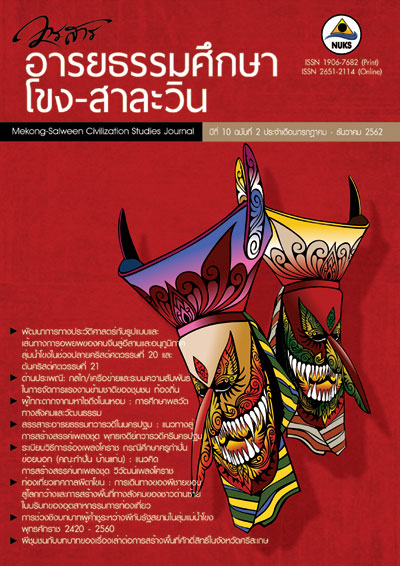ผีชุมชนกับบทบาทของเรื่องเล่าต่อการสร้างพื้นที่ศักดิ์สิทธิ์ในจังหวัดศรีสะเกษ ผีชุมชนกับบทบาทของเรื่องเล่าต่อการสร้างพื้นที่ศักดิ์สิทธิ์ในจังหวัดศรีสะเกษ
Main Article Content
บทคัดย่อ
บทความวิชาการนี้ต้องการตั้งประเด็นศึกษาเกี่ยวกับเรื่องเล่าที่สัมพันธ์กับผีในแต่ละชุมชนในมิติทางด้าน บทบาทการสร้างพื้นที่ศักดิ์สิทธิ์ในจังหวัดศรีสะเกษ คือ 1. เรื่องเล่าผีปู่ตากับบทบาทในการสร้างพื้นที่ศักดิ์สิทธิ์ 2. เรื่องเล่าผีป่ากับบทบาทการสร้างพื้นที่ศักดิ์สิทธิ์ 3. เรื่องเล่าผีหนองน้ำกับบทบาทการสร้างพื้นที่ศักดิ์สิทธิ์ 4. เรื่องเล่าผีโนนกับบทบาทการสร้างพื้นที่ศักดิ์สิทธิ์ โดยใช้แนวคิดเกี่ยวกับเรื่องเล่า และแนวคิดเกี่ยวกับพื้นที่ศักดิ์สิทธิ์ในการวิเคราะห์ จากการศึกษาพบว่า ในเขตพื้นที่จังหวัดศรีสะเกษมีเรื่องเล่าเกี่ยวกับผีชุมชนต่าง ๆ คือ เรื่องเล่าผีปู่ตาที่ยังสัมพันธ์ และมีบทบาทกับผู้คนในชุมชนด้านการสร้าง และธำรงข้อปฏิบัติต่อพื้นที่ศักดิ์สิทธิ์ ช่วยยึดเหนี่ยวจิตใจของคนในชุมชนรวมถึงทำหน้าที่ควบคุมสังคม เรื่องเล่าผีป่าที่ชาวบ้านให้ความเคารพในฐานะที่มีบทบาทการสร้างพื้นที่พิเศษที่มักมีอนุภาคเกี่ยวกับสัตว์ที่กลายเป็นสัตว์ศักดิ์สิทธิ์ เรื่องเล่าผีหนองน้ำที่มีบทบาทช่วยทำให้แหล่งน้ำที่เป็นพื้นที่สามัญกลายเป็นพื้นที่ศักดิ์สิทธิ์ นัยหนึ่งของเรื่องเล่าดังกล่าวจึงสะท้อนถึงระบบบริหารจัดการน้ำของผู้คนในชุมชน โดยมีเรื่องเล่าผีหนองน้ำเป็นสื่อกลางในการถ่ายทอดกุศโลบาย และเรื่องเล่าผีโนนที่มีบทบาทเกี่ยวข้องกับไสยศาสตร์ รวมถึงการเสียชีวิตของผู้คนในชุมชน โดยมีนัยของการต่อรองทางศาสนาและความเชื่อ คือ ศาสนาพุทธและความเชื่อเรื่องผี เรื่องเล่าดังกล่าวได้มีบทบาทในการสร้างอำนาจเพื่อกำหนดขอบเขตของพื้นที่ทางภูมิศาสตร์ของโลกสามัญให้กลายเป็นพื้นที่ทางจิตวิญญาณที่เรียกว่าโลกศักดิ์สิทธิ์
Downloads
Article Details
เอกสารอ้างอิง
Boonhai, K. Interviewed on September 20, 2014.
Buasri, N. Interviewed on September 19, 2014.
Boonsing. R. Interviewed on September 18, 2014.
Champaphan, S. Interviewed on October 21, 2014.
Chansanith, P. Interviewed on October 2, 2014.
Chanthasorn, A. Interviewed on October 23, 2014.
Chanthasorn, S. Interviewed on October 21, 2014.
Choopoo, N., Boonprakarn, K. and Tepsing, P. (2016). "The Construct
a Sacred Space and The Ritual of Khian Bang Kaew Temple,
Khao Chaison District, Phatthalung Province,” in 7th Hat Yai
National and International Conference, Hat Yai University.
June 23, 2016. 69-89.
Deelert, S. Interviewed on September 25, 2014.
Deesomchok, P. (2009). Perceptions, ways of thinking and
adaptation in the use of the ancient city area of Dong
Lakorn community, Dong Lakorn sub-district, Muang
district, Nakhon Nayok. Sociology and Anthropology MA
Thesis, Thammasat University.
Fiengfusakul, A. (2008). Anthropology of Religion: Basic concepts
and theoretical debates. Department of Sociology and
Anthropology Faculty of Social Sciences, Chiang Mai
University.
Hawanon, N. (2009). “Methods of study on storytelling: the turning
point of social science research,” Journal of Mekong
Societies. 5 (2): 1-22.
Hongsuwan, P. (2014 a). Mekong River: Myths and relationships
with the Tai people. Research paper. Bangkok: The Thailand
Research Fund.
_______. (2014 b). “Dong Phu Din: sacred tales and constructing
meaning practice on community rights,” Journal of Mekong
Societies. 10 (3): 167-192.
_______. (2011). Folklore and Thai people. Teaching documents.
Department of Thai and Eastern Languages, Faculty of
Humanities and Social Sciences, Mahasarakrm University.
Jones, R. (1986). Emile Durkheim: An Introduction to Four Major
Works. Beverly Hills, CA: Sage Publications, Inc. Pp. 115-155.
Kaewthep, K. et al. (2011). Folk media studies in communication art.
Bangkok: Senior Research Scholar Fund, Academic
department, The Thailand Research Fund.
Kantong, S. Interviewed on October 23, 2014.
Keawhawong, L. Interviewed on September 29, 2014.
Kengpanich, S., Gasorngatsara, S., Boonyasurat, W. (2016). "The
management of the sacred mountain area, Wat Mon Phraya
Chae for a pilgrimage place and cultural tourism,” in
National and International Conference on Research and
design in Architecture and Related Fields. Princess Maha
Chakri Sirindhorn Anthropology Centre, December 19-20,
pp 125-158.
Ketthet, B. (1999). “Don Pu Ta Forest Institute and the behavior role
of Tao Jam in the Isan community,” Mahasarakrm University
Journal. 17 (2): 193 - 210.
Khamsri, M. Interviewed on September 19, 2014.
Kongsim, U. Interviewed on October 6, 2014.
Kraiya, S. Interviewed on September 20, 2014.
Kraiya T. Interviewed on September 20, 2014.
Lefebvre, H. (1991). The Production of Space. Translated by Donald
Nicholson-Smith. Oxford: Blackwell.
Maneenin, D. Interviewed on October 6, 2014.
Maphob, N. Interviewed on October 18, 2014.
Na Thalang. S. (2002). Tai people in tales: passing folklore lens and
folk literature. Bangkok: Matichon.
Nakarin, L. Interviewed on October 20, 2014.
Nuansaeng, P. and Thepwongsirirat, P. (2015). “The sacred landscape
of upstream areas and the creation of environmental
management tools: In the case of Nam Nao big cave in
Phetchaboon province,” Kasembandit Journal. 16(2): 32-54.
Phothila, K. (2012). The analyzes study on the influence of beliefs
on ghouls in related to Buddhist rituals: case study of
Ban Don Ya Nang, Kalasin province. MA Thesis in Buddhism,
Mahachulalongkornrajavidyalaya University.
Pimpha, F. Interviewed on September 29, 2014.
Praphasajjavet, K. Interviewed on September 18, 2014.
Singkeaw, V. Interviewed on September 18, 2014.
Sipipattanakun, W. 2015. “Variation of the Northeastern Thai tone in
Sisaket Province in 5 language communities,” Language and
Culture Journal. 34(1): 61-84.
Smutkupt, S. et al. (1996). Spirit Mediumship: Discourse of the cult
and crisis of modernity in Thai society. Bangkok: Princess
Maha Chakri Sirindhorn Anthropology Centre (Public
Organisation).
Sriboonreung, S. Interviewed on September 18, 2014.
Sriboonreung, T. Interviewed on September 30, 2014.
Sriboonreung, W. Interviewed on September 18, 2014.
Sringam, W. Interviewed on October 21, 2014.
Sriyongyod, B. Interviewed on October 2, 2014.
Suebsa, S. Interviewed on October 25, 2014.
Sukkomsai, W. Interviewed on September 25, 2014.
Suphathid, N. (2010). “Superstition in folk tales in Chonburi province:
the belief persists,” Journal of Politics, Administration and
Law. 2 (3): 193-211.
Suveeram, P. Interviewed on October 6, 2014.
Thaignuloem, J. and Thinrat, P. (2014). Shared Language and cultural
characteristics in Thai folk tales and Lao PDR. folk tales,”
Journal of Liberal Arts Prince of Songkla University. 6 (1):
-43.
Thanissaro, N. Interviewed on October 2, 2014.
Thongsean, P. Interviewed on October 21, 2014.
Wallipodom, S. (1999). Sacred mountains and universality. Bangkok:
Muangboran.
Wannasiri, N. (1997). Social and Cultural Anthropology. Department
of Sociology and Anthropology Faculty of Social Sciences,
Kasetsart University.
Wongkerd, P. (2012). Analysis of myths on elephants in Thai Kui
folk tales in Surin Province. MA Thesis in Communication
Arts, Dhurakij Pundit University.


